This build has been archived by the author. They are no longer supporting nor updating this build and it may have become outdated. As such, voting and commenting have been disabled and it no longer appears in regular search results.
We recommend you take a look at this author's other builds.
This guide has not yet been updated for the current season. Please keep this in mind while reading. You can see the most recently updated guides on the browse guides page
 Thank You!
Thank You!
Your votes and comments encourage our guide authors to continue
creating helpful guides for the League of Legends community.
Recommended Items
Runes: Standard


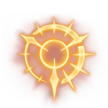
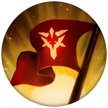
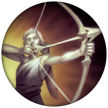
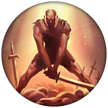

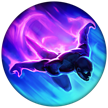
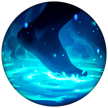
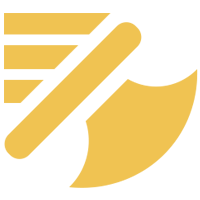


+10% Attack Speed
+9 Adaptive (5.4 AD or 9 AP)
+6 Armor
Spells:

Flash

Smite
Items
Ability Order

Eternal Hunger (PASSIVE)
Warwick Passive Ability

 |
Hi, I'm PsiGuard and welcome to my Warwick fills a lot of the criteria I look for in a jungler. He has great dueling, good jungle sustain and can chase down his own kills. Like Before we begin, I'd like to give a big thank-you to Jovy for her awesome graphics and help with coding this guide (as well as my other guides). Be sure to check out some of her other work at her signature shop and her own guides! |
|
About Warwick /// Runes /// Spells /// Abilities Ability Sequence /// Item Build /// Jungle Monsters Plants /// Warding /// Jungle Routes /// Ganking Wave Management /// Late Game /// Conclusion |

 |
Warwick is a bit of a jack-of-all-trades compared to most other options in the jungle role. He has a solid early game, respectable jungle clear, good dueling and reliable ganking tools. He's not the best at any of these things, but he's good enough to get the job done. Warwick's high jungle sustain also makes him a pretty great choice for new junglers, since his clear is simple and safe and he has tools to handle just about any situation. Apart from his versatility, I'd consider Warwick's biggest strength to be his powerful early game. His sustain means he'll be at full health throughout the early game, regardless of what jungle route he takes or how strong a leash he receives from his teammates. His healing from Warwick's biggest weaknesses are his lack of AoE damage and fairly low burst. For a champion with entirely single-target abilities, Warwick can't actually deal a lot of damage quickly unless he's insanely ahead. Instead, he needs time to wear down his targets until they're low enough to activate |




|
|

|
This is the only viable rune for this row. Despite Warwick's self-healing, |

|
|

|
This rune has some synergy with Warwick's self-healing, as it'll make you more dangerous as you get low on health. It's good for 1v1s, tower dives and it can significantly increase your healing in team fights if you get a Q or R off while you're around 30% HP. |


|
|

|
One of the strongest early game runes for jungle if you fight in the river. Warwick can already win most 1v1s in the river against enemy junglers, but the extra stats and mobility can help you finish kills more quickly or chase a little more effectively. Also helps when fighting |

Resolve offers better healing and survivability at the opportunity cost of mobility. This is more of a scaling page for front lining in team fights.

|
Warwick is a fantastic duelist, so |

|
Warwick has a lot of self-healing, especially when he's low on health. This rune has some nice synergy with |



|
This spell is essential for jungling, as it unlocks the jungle-only items which you need to keep up in experience. The spell is also essential for securing monster objectives like buff camps, dragon and baron. Building |

|

|
This is a core spell on most champions in the game and Warwick is no exception. In addition to the flexibility it adds by allowing you to dodge skillshots, hop walls and escape death, Warwick can use it to get in range for |



This is a pretty simple passive that you don't have to think much about. You'll heal only when below half HP, and much more if you're below 25% HP. This, combined with the attack speed from
In the jungle this actually doesn't come into play much, other than if you're soloing dragon. You can usually keep your HP above 50% with
One thing to note is that this is one of three damaging abilities available to Warwick, all of which deal magic damage. This splits his damage fairly evenly, allowing him to fit into more compositions and making him more difficult to itemize against.


Jaws is your spammable source of damage and healing both in the jungle and when fighting champions. It deals a respectable amount of damage and has a total AD ratio, which allows Warwick to scale well in damage without having to build much AD. Ranking up this ability mainly increases the healing (though it'll deal a bit more %HP damage too) as there is no base damage to scale with rank and the cooldown doesn't go down.
If


 ) to dashes (
) to dashes (


 ) and even teleports (
) and even teleports (


 )! Mastering this function is crucial for securing kills against mobile targets, plus it looks pretty flashy.
)! Mastering this function is crucial for securing kills against mobile targets, plus it looks pretty flashy.Simply pressing (and immediately releasing) Q is a lot quicker than holding Q, so it's useful when clearing jungle camps or otherwise dealing damage without slowing down your DPS from basic attacks (like in close 1v1 fights). If you don't want to follow an enemy champion through their dashes or blinks (which can be dangerous if they're close to their tower or teammates), you can just tap Q for some quick damage. In most cases you'll be chasing down enemies, so you'll usually want to hold Q.
Press and hold Q on your target while chasing enemies and you'll cast it as soon as you get in range.
Thankfully, holding Q does not follow recalls. This means you won't accidentally get dragged to the enemy fountain if you hold Q on an enemy at the end of their recall.
Holding Q also renders Warwick immune to displacement while he's attached to his target, so you can use it to avoid being knocked up or back by enemy abilities if you time it right. This also allows you to Q straight through
If you're using manual (normal) casting, you'll need to click-and-hold the target until Warwick reaches the target. If you're using quick-cast, you'll need to hold down the Q key until he latches on.
Some abilities like
Jarvan's telegraphed dash makes it easy to follow him by holding Q.


Blood Hunt's power is largely contained in its passive effects. Out-of-combat movement speed allows Warwick to show up to fights and chase target that most junglers wouldn't be able to catch, while the bonus attack speed makes him much more effective at fighting targets who are already below half.
Since
In addition to the bonus stats it offers, tracking a Blood Hunted target also reveals a visible scent trail that leads from Warwick to the Blood Hunted champion, even if they're in fog-of-war. Warwick needs to see the enemy when they become low on health to start Blood Hunting them, but once they enter fog, the trail will still show their location until they're able to heal up above half HP again. This makes it easy to track enemies who've retreated after a fight. You'll know if they're continuing to run away or if they decide to recall. If they recall in an unsafe location, you can run them down for an easy tower dive or catch them in a bush unawares. The only way to see their exact location is to move your map to follow the trail and see where it ends.
After activating
The active portion of this ability isn't terribly reliable since it only Blood Hunts the nearest enemy champion, which sometimes isn't the target you want or the direction you want. Nevertheless it can be useful for reaching enemies that aren't low enough to be passively Blood Hunted, as well as granting the attack speed bonus against the hunted target. Your enemies will hear an audio cue when you are Blood Hunting them, so keep in mind that activating this ability will signal to your enemy that you're nearby and probably chasing them.
Be sure to activate Blood Hunt (if you don't have a passive trail already) before casting
Finally, keep in mind that the movement speed and active effects both require you to be out of combat, so you'll need to activate this before you start fighting. In cases where the nearest enemy is already below 50% HP, you can save the cooldown for later and just use the passive effect.
Blood Hunt has a limited range (4000) at which it can sense "nearby" targets, so be sure to mouse over the ability to check the range before attempting to sense an enemy that's fairly far away. If you do waste a cast of W, the plus side is that it cools down twice as fast if you're not Blood Hunting an enemy.


Damage reduction works on all sources of damage except true damage, which means it's effective not only against champion damage, but against monsters and tower damage as well. It's on a fairly lengthy cooldown, so make sure you use it at the right time to reduce the most damage possible.
You can reactivate Primal Howl to end the damage reduction and cause all nearby enemies to Flee in fear for 1 second. You need to wait a short delay before being able to re-cast the ability. If you don't re-cast, Warwick will automatically howl at the end of the full 2.5 second duration of the damage reduction.
Cast
Since Flee (also known as Fear) effects not only disable enemies, but also force their movement away from the caster, it's important to put yourself on the opposite side of any enemy you're chasing before causing them to Flee, if possible. This can usually be achieved by holding down
Warwick will immediately howl upon contacting an enemy champion with


Infinite Duress' range depends a lot on Warwick's current movement speed. If you have
It is surprisingly easily to miss this ult, and if the enemy sees you coming, they could also dodge it with
By chaining
If you have
The leap portion of Infinite Duress cannot be cancelled by crowd control, but the suppression can be interrupted. This makes it a pretty effective escape tool if absolutely necessary, but if you're jumping into several enemies with interrupts, you'll want to wait until those cooldowns are down, or at least prime
Champions with skillshot CC are vulnerable to direct engages with
Infinite Duress applies on-hit effects three times over the duration of the channel, including procs of



I'll preface this by saying that Warwick's abilities are all pretty useful to max out, so there isn't going to be a huge difference if you max a different ability first. The one exception would be
Personally, I max
Like most ultimates,
If you want to do something different, maxing Q first will give you a bit more up-front damage and better in-fight sustain. Maxing E second can make you a stronger frontline in team fights, assuming you don't howl immediately. I've seen a number of successful Warwick players with varying ability sequences, so don't feel too restricted if you want to try something different. If you're not sure what to do, feel free to simply follow the above sequence though. I find it's pretty reliable.




|

|
I recommend starting with |


|
Switch to |


|
Try to get Tiamat on your first recall if possible. This item makes a huge difference in clear speed, especially on the Raptor camp. It also gives you some early AD which helps in fights. You don't need to upgrade it to |

|
I prioritize |


|
Ninja Tabi tend to be the best option to reduce damage taken against a balanced team composition. Almost all teams have a Marksman which will eventually be a significant damage threat, so you'll be mitigating a lot of damage with both the armor and basic attack damage reduction from these boots. Armor also protects against monster, minion and tower damage, so it's a reliable stat if the enemy team doesn't have enough crowd control to warrant |

|
Mercury's Treads are your counter to reliable and/or long-lasting crowd control effects (other than knockups or suppression, which aren't reduced by tenacity). Look out for spells like |


|
Between Warrior and Cinderhulk, Cinder has the safer stats. You can do your job as a skirmisher and front liner well enough with just |

|
This is your main source of damage if you're building Cinderhulk. Warwick procs a lot of on-hits with |


|
|

|
Since this item gives decent resistances, it can work as a mid-late game option after you've finished your main HP items. Works well with |


|
A straightforward and reliable armor option, Dead Man's Plate gives you a solid mix of stats as well as a lot of movement speed to extend your |

|
Good against high healing champions that will be attacking you. |

|
Randuin's is a strong counter to autoattackers that build critical strike items. Keep an eye out for champions like |


|
Spirit Visage is a pretty obvious choice for magic resist on Warwick. Health fuels your |

|
Adaptive Helm has a worse build path than |



Familiarize yourself with these spawn times and respawn timers so you know what to expect in-game.
 |
Dragon (Elementals & Elder) Spawns At: 5:00 Respawn Time: 5:00 Elder Dragon Spawns: 6:00 after a team gets 4 Drakes Elder Dragon Respawn: 6:00 |
 |
Baron Nashor Spawns At: 20:00 Respawn Time: 6:00 |


Plants are stationary, neutral units with 1 health. They can be destroyed with a basic attack to trigger an effect. Three different types of plants will spawn in the jungle and river. Their spawn timers and locations vary slightly but for the most part they are fairly predictable. The first spawn locations for all plants are predetermined.


|
First inner cone spawn: 1:15 - 1:25 First outer cone spawn: 5:00 - 5:30 Inner cone respawn time: 5 - 7 minutes Outer cone respawn time: 5.5 - 6.5 minutes |
- Knocks away nearby units (including the attacker) when destroyed — even over walls.
- Blast Cones spawn in two spots per jungle quadrant, an inner point toward the center of the quadrant, and an outer point near Baron/Dragon.
- In an Infernal Rift game (3rd Dragon is Infernal), additional Blast Cones will spawn near each tri-bush by Gromp, by the Wolf Camp, in front of each base's gates and in the alcoves.

|
First spawn: 3:00 - 3:30, always at each quadrant’s spawn point nearest to the side lanes Next spawn time: 5 - 6.5 minutes at either spawn point, starting once a given quadrant's Scryer's Bloom is destroyed |
- When destroyed, releases vision-granting pollen in a large cone that flies in the direction the attacker was facing, revealing units and wards for 12 seconds (3 seconds on champions).
- Scryer's Bloom can spawn in two spots per jungle quadrant, close to river ramps.
- Only one Scryer's Bloom can be present per quadrant.
- In a Cloud Rift game (3rd Dragon is Cloud), additional Scryer's Blooms will spawn in front of each base's gates and in front of each tri-brush in the river.

|
First spawn: 6:00 - 6:30 minutes Respawn time: 5.5 - 7 minutes |
- Drops 5 fruits on the ground when killed.
- Each fruit heals for 3.5% of max health or 8 (+6 per level) flat health, whichever is higher.
- Eating a fruit slows you for 35% for 0.25 seconds.
- Honeyfruit spawn along river walls, starting near Dragon or Baron pits and slowly extending closer toward lanes over the course of the game.
- If a Honeyfruit isn't taken before its respawn timer completes, a second Honeyfruit may spawn. No more than two Honeyfruits can exist per half of the river.


As a jungler, you have the most agency when it comes to traversing the map to place down vision, especially in the enemy jungle. When it's safe to do so, try to place deep wards to keep track of the enemy jungler.
Placing a
As the game progresses, you may have to start placing wards nearer to your base if you're losing, or deeper into the enemy jungle if you are winning. Always remember to place a
Below are some of the more valuable ward spots. Of course, warding is always situational, so don't feel restricted to only using these placements if the situation calls for something else.
 |
 |
|
Blue side stealth ward locations
|
Blue side control ward locations
|
 |
 |
|
Red side stealth ward locations
|
Red side control ward locations
|


Standard Routes
 Blue - Gromp - Wolves - Red - Gank -
Blue - Gromp - Wolves - Red - Gank -
 Scuttle: This is the most efficient route for Warwick at the moment. You'll hit 3 with an optional mid gank after Wolves, but if you don't see an opportunity, just pick up your red buff and look for a gank or fight before Scuttle spawns.
Scuttle: This is the most efficient route for Warwick at the moment. You'll hit 3 with an optional mid gank after Wolves, but if you don't see an opportunity, just pick up your red buff and look for a gank or fight before Scuttle spawns. Blue - Gromp - Red - Gank This is the the fastest way to hit level 3 with double buffs for a quick gank timing. You can also do this route in reverse (Red - Blue - Gromp) to gank the opposite side lane.
Blue - Gromp - Red - Gank This is the the fastest way to hit level 3 with double buffs for a quick gank timing. You can also do this route in reverse (Red - Blue - Gromp) to gank the opposite side lane.Vertical Jungling
Vertical jungling is when both junglers are repeatedly clearing one half of the allied jungle and one half of the enemy jungle, favoring one side of the map. This splits the map into a "strong side" and "weak side" for each team. For example, if you're on blue team and are repeatedly clearing your red-side jungle (south) and the enemy blue-side jungle (east), your team's bottom side will be the strong side of the map. You'll be in a better position to gank bottom lane without fear of counterganks and you'll have better vision control and objective control. Likewise, the opposite side of the map will be dominated by the enemy jungler, making it your team's weak side.
Vertical jungling can be an active choice you make or a forced one due to a poor matchup. For example, you see
An example of an active choice would be if you and your team (this works better in arranged teams than it does in solo queue) decide to focus all of your team's pressure on one side lane at the expense of the other. Maybe you have a hypercarry bottom that your team will be camping and a
Vertical jungling is pretty complicated for new junglers and can be pretty messy outside of coordinated teams. Be open to the concepts and feel free to practice it, but for most players I recommend sticking to more standard routes or simple, quick invades while you're still learning to jungle.


Once you have
Activate
|
Keep in mind your ultimate has a long cooldown early game and can often be dodged with |
|

Top lane tends to be the easiest lane to gank, as top laners have sparse ward control and often play very aggressive to win lane 1v1. Since top is a long lane, you can usually find opportunities to either gank pushing enemies from a flank or to dive the enemy tower. Ganking top is most rewarding when you can turn a losing lane into a winning one, but in some matchups this isn't really feasible.
Analyze the top lane matchup and see what strengths and weaknesses both champions have. Provide vision control for aggressive laners like
|
In this gank I wait until |
|
|
I approach this gank by cutting off |
|

Mid lane can be very difficult to gank, depending on matchup. Some champions like
If you have strong setup like
If your mid laner is pushing constantly, don't worry if you can't gank his lane opponent. Put down wards to protect your pushing mid laner from enemy ganks (and be sure to countergank if you see one coming). Ask your mid laner to help you in invades and ganks if they're pushing, since it'll be almost impossible for the enemy mid laner to help while they're farming under tower.
If your mid laner is getting pushed under tower, but you can't effectively gank the enemy mid, be very wary about going past river and watch for the enemy mid to roam to other lanes or even your jungle. Place wards defensively to spot enemy roams.
Be really careful about diving mid, since the two mid towers are very close together, making it easy to retreat. You're also in the center of the map, so it's much more likely that the enemy jungler is nearby.

Bottom lane is the riskiest place to gank, but also the most rewarding. You have the opportunity for a double kill (or on a countergank, a triple kill) and you can use that numbers advantage to take a tower or kill dragon. If you gank very early (at level 3 or 4), your bot laners might need to use that time to just push in the wave and recall for their items, so don't force objectives too hastily if it'll cost your laners a good recall timing.
Bot lane is tough to gank because they have much better ward coverage and double the combat summoner spells to use against you. Be sure to keep track of which summoners the enemy bot laners have used before you gank. Ask your bot lane for help if you don't know which summoners are up. If you're going to wait for a few seconds in a bush, make sure it isn't warded!. River bush and tribush are often warded, so only camp there if you have a
With



If you manage to kill your target in a successful gank, you'll usually want to help your laner push the wave to the enemy tower so that your minions are killed by the tower, denying the enemy laner gold and experience. The minion waves will also reset to the center of the lane, giving your teammate time to go back to base and buy items and return to a safe position. One exception to the push-after-ganking rule is if you gank very early in the game against an enemy with

After a successful gank, usually when pushing to the enemy tower, you may want to take a minion tax. This means you'll take some of the farm to help you keep up in gold since you had to spend time ganking rather than farming your jungle. You'll generally want to tax more heavily if your laner gets the kill off a gank and tax lightly if you took the kill. Many low-ranked players (and occasionally some high-ranked ones too) are selfish or ignorant and think that taxing their lane is going to ruin their farm and cause them to lose the lane. They're wrong, as taxing in moderation keeps a jungler's gold and experience relevant throughout the game, but if your laner freaks out because you took a few minions (or pushed their lane, some people think this is a bad thing all the time), you may want to just leave so they don't feed or AFK or something.

Holding lanes is an often necessary duty of a jungler and is something you should be happy to do (since it gives you a lot of gold and XP). If your laner dies or needs to go back to base, you may need to "hold" or "cover" their lane by clearing out enemy minions pushing to your tower. If the enemy laner goes back to base or is dead, you may wish to push the wave to the enemy tower. Only do this if you can finish pushing before the enemy laner gets back to lane or they can freeze it in front of their tower, making it difficult for your laner to farm safely. Usually holding a lane consists of either clearing the current wave that is at your tower or pushing completely to the enemy tower. Don't just sit in a lane and last-hit because it's a waste of your time.


Keep in mind that your durability from armor items and sustain from your abilities makes you pretty effective at tanking baron or elder dragon, so you can always start an objective even if you just use the pressure to bait someone in for a free kill. Warwick isn't terribly fast at clearing baron, but if you have a high DPS carry like
In team fights, you'll either want to use
One final tip I'll give you is that Warwick can fully heal off nearby minions or jungle camps very quickly. Use


Thank you for reading my
A special thank you to those who have supported my guides with votes, Scout points and advice that have been instrumental in bringing my guides to the level of quality they are today.
 | A very special thank you to Jovy for her wonderful graphics used in this guide as well as her help with coding all my guides. All the fancy headers, table of contents and most of the other graphics you see in my guides are from her. Be sure to check out some of her other work at her signature shop and her own guides! |












 10,860,864
10,860,864
 301
301







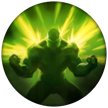
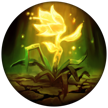














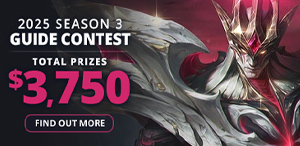
 Twitter
Twitter
 YouTube
YouTube
 Twitch
Twitch
 PayPal
PayPal

You must be logged in to comment. Please login or register.